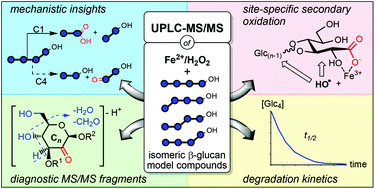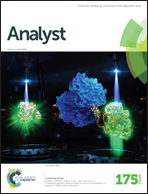UPLC-MS/MS investigation of β-glucan oligosaccharide oxidation†
Abstract
Polysaccharide degradation mediated by hydroxyl radicals (HO˙) or lytic monooxygenases (LPMOs) is relevant in various biological and industrial processes. Thereby, the Fenton-induced (H2O2/Fe2+) oxidation of mixed-linkage (1→3,1→4)-β-D-glucan (BG), a cereal dietary fibre with several well-established health promoting properties, shows potential for modulating BG functionality. The precise identification of oxidation products, however, is impeded by their diversity due to the indiscriminate nature of HO˙, the large molecular weight, and the corresponding low frequency of discrete alterations along the polymer chain. In this paper, we studied the Fenton-induced degradation of several constitutionally isomeric glucotetraoses as BG model compounds by hydrophilic interaction UPLC-MS/MS in negative ion, high resolution mode. The influence of the β-(1→3)-linkage on the reaction was investigated with regard to degradation kinetics, formation of products, and MS/MS fragmentation patterns. The position and occurrence of a β-(1→3)-bond had no influence on the degradation kinetics. Classification into primary and secondary acidic oxidation products by monitoring their progress over time is also demonstrated, implying complexation of primary aldonic acid products by the catalytic iron and subsequently facilitated site-specific secondary oxidation, underlining the metal's importance beyond its role as HO˙-generating catalyst. Similarly to oxidations mediated by certain LPMOs, thorough MS/MS-analysis of selected products and comparison with synthesised standards confirmed two types of glycosidic cleavage cascades induced by HO˙-mediated H-atom abstraction at C1 and C3/C4, producing gluconic acids, native oligosaccharides, and oxo-oligomers (carbonyl at non-reducing end). Additionally, systematic study of other oxo-products from the different isomers and rationalisation of MS/MS fragmentation mechanisms allowed for the identification of potentially diagnostic fragment signals for oxidised cereal BG.


 Please wait while we load your content...
Please wait while we load your content...